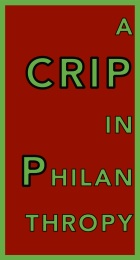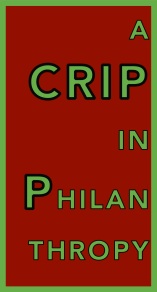-
Subscribe
Subscribed
Already have a WordPress.com account? Log in now.
 I’m a crip in grant-making philanthropy! Whoopee! As of November 1, I became a Trustee of Awesome Foundation’s Disability Chapter. It only took 25 years of being on the grant-seeking side of
I’m a crip in grant-making philanthropy! Whoopee! As of November 1, I became a Trustee of Awesome Foundation’s Disability Chapter. It only took 25 years of being on the grant-seeking side of  An earlier version of these remarks was shared at Congregation Beth Jacob in Redwood City, California on March 3, 2018. I deeply appreciated their welcome when I was invited to address their community by Anne Cohen, an activist, disabled parent, and board member at the organization where I am Director of Development, Disability Rights Education & Defense Fund (DREDF) or, as Anne has dubbed it, “the ACLU of disability rights.” CBJ’s cross-disability access allowed me to take the first step in organizing community support: communicate.
An earlier version of these remarks was shared at Congregation Beth Jacob in Redwood City, California on March 3, 2018. I deeply appreciated their welcome when I was invited to address their community by Anne Cohen, an activist, disabled parent, and board member at the organization where I am Director of Development, Disability Rights Education & Defense Fund (DREDF) or, as Anne has dubbed it, “the ACLU of disability rights.” CBJ’s cross-disability access allowed me to take the first step in organizing community support: communicate.